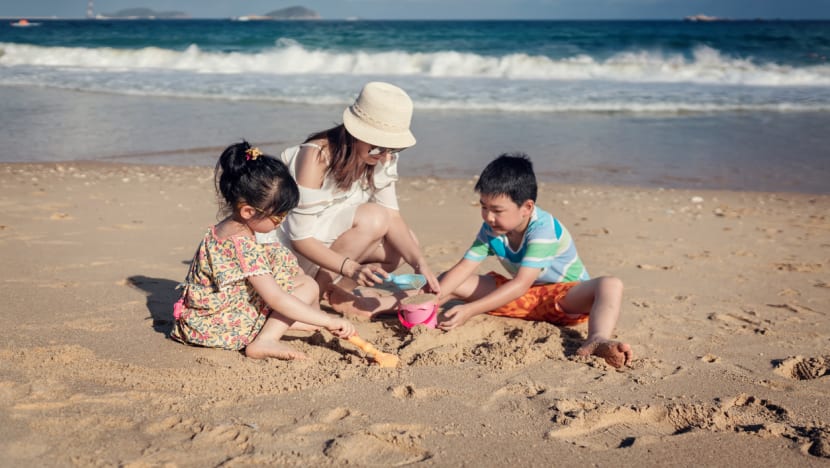Commentary: Parents, do you know how to play with your children?
Golden opportunities for learning are lost when parents focus only on the safety of their children and mediating sibling squabbles during playtime, instead of engaging with their little ones, says SUSS’ Dr Cynthia Lim.

A mother and her children building a sandcastle together. (Photo: iStock/MarsYu)
SINGAPORE: “Don’t rub your eyes, there’s sand in your hands,” a mother instructs her 4-year-old girl playing at the sand pit, in between glances from her mobile phone. Five minutes later, the mother looks up from her phone again and calls out: “Be careful” and “Good job!”.
Many parents are guilty of this behaviour – taking on a supervisory role instead of engaging their children during play.
The importance of learning through play for young children is widely known, yet many parents are not physically involved in their children’s play.
At a recent educational conference, researchers from a Hong Kong university presented their research on a programme designed to teach parents how to play with their pre-school children.
The programme was popular and well-subscribed, with parents admitting they needed help learning how to engage their children in creative play. The researchers concluded that parents needed a space to rediscover the joy of play and more importantly, how to play with their children.

WHY DO ADULTS NEED TO BE TAUGHT HOW TO PLAY?
What does this say about parents? Have adults forgotten how to play? Do adults really need to be taught how to play with their own children?
Parents are so caught up in assuming their role as guardians of their children that it’s not surprising they focus squarely on keeping their little ones safe during play.
Those with more than one child know painfully well how much of playtime is spent mediating conflicts between squabbling siblings. Time pressures of work and chores also reduce the amount of quality time and energy parents can spend with their children.
Even if parents are committed to spending quality time playing with their children, they may not know how to.
The Internet provides an overwhelming number of suggestions and activities for play that parents can organise for their children, but clear advice on how to facilitate learning and development through such play may still be lacking.
As a parent of an only child, I have had my fair share of doubt about balancing my role as a mother versus a playmate.
What should I say or do during play? Do I assume the role of a playmate or a mother? What sort and how much guidance should I provide? Am I taking too much control and am I hampering his imagination and agency in my interaction? These are valid and important questions adults may not often think about.
Play is vital to children’s physical, cognitive, social, and emotional development. Play provides rich opportunities for children to explore ideas, make meaning of the world around them, interact with others and develop important life skills while engaging in meaningful and fun activities.
Play is enjoyable, yet hard work as there is a lot of learning going on for young children that may go unnoticed to an adult’s eye.
LEARNING OPPORTUNITIES DURING PLAY: ASKING QUESTIONS
Many golden opportunities for learning are lost when parents simply provide the toys and police the safety or act as mediators during playtime.
Adults can facilitate creative idea generation, challenge their thinking, encourage problem-solving, ask questions related to the play situation or simply be a cheerleader.
For example, at the sand pit, if the mother had asked her daughter to describe what she had built, the girl would have had the chance to use descriptive language or weave a story around her creation to do an impromptu “show and tell”.
The mother could encourage her daughter to explore ideas of height measurement as a math concept by making comments such as “Look at how tall your friend’s sandcastle is”.
Probing questions such as “Your sandcastle is about to fall, how can we make it more stable?” would support idea generation, critical thinking as well as problem solving.
While not all parents may know how to ask these types of questions, a simple question like “Tell me what you are doing?” opens doors for a conversation between adult and child that supports meaningful shared and sustained interactions and exploration of concepts.
Such interactions between the adult and child can also lead to building a stronger bond and a healthy parent-child relationship. We must never underestimate how much it means to the child that her mother cares about what she is working on in the sand pit.
Perhaps if we spend more time observing our children at play, we will better understand what interests and motivates them. We will then be in a better position to ask the right questions to support their learning.

OPEN-ENDED TOYS PROMOTE LEARNING AND HAVE STAYING POWER
With the Christmas season just over, what toys did you get your children? Have you wondered why some toys get chucked aside after children play with it for a short time while others have more long-lasting interest? This usually has to do with how open-ended the toys are.
For toys that can only be played with in limited ways, the child is likely to get bored after he has exhausted the ways in which the toy can be manipulated.
Toys that are interesting and engaging are typically open-ended and allow for endless possibilities of play, for example, play dough, sand play and building bricks.
In fact, open-ended toys need not be expensive. Recycled materials or items around the home such as cardboard boxes, egg cartons, bottle caps, ice-cream sticks, and paper rolls are flexible materials to work with in constructing structures or creating crafts.
How about educational applications and gadgets? Parents may think that these are helpful for their child’s learning but are they really “educational”?
With the proliferation of educational applications in an unregulated market, there has been little and mixed evidence to show the effectiveness of such products.
Even if the educational application or gadget claims to be interactive and engaging for the learner, the vast majority of such programmes involve direct teaching and rote learning that does little to develop deep and conceptual learning for children.
Games and activities that encourage children to create, build and make decisions or problem solve allow for development of skills and thinking compared to those that promote memorising and learning through drill and practice.
As we step into the New Year, this may be the best time for parents to reflect on how we can bring out the best during playtime, not only for our little ones but for us as well.
Dr Cynthia Lim is a senior lecturer with the Early Childhood Education Programme at the SR Nathan School of Human Development, Singapore University of Social Sciences.





















